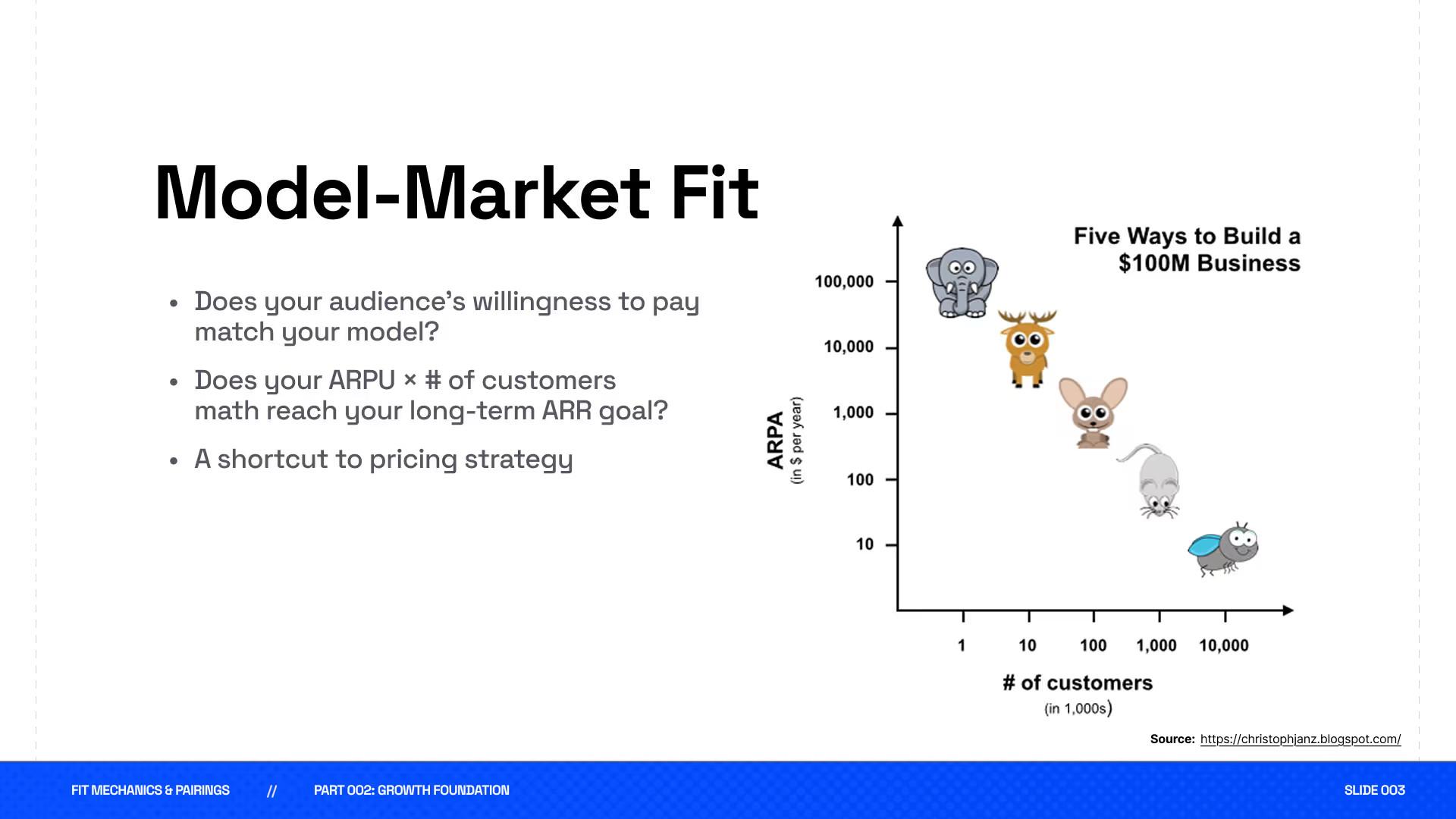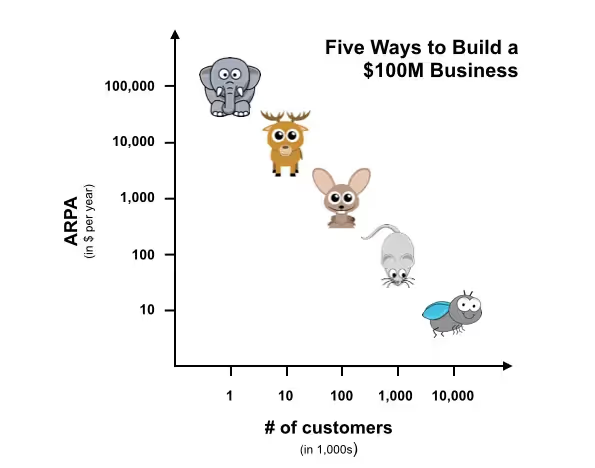
Conversation

🥳 Feedback Received!
Thanks for taking a moment to share your thoughts — it genuinely helps us make each chapter sharper.
What happens next:
- Your feedback goes straight to our product team.
- We’ll use it to refine lessons, clarify examples, and make the program even more useful.
Appreciate you helping make this program better for everyone.
Ready for your next challenge? 👇
Model-market fit
Next, let's look at Model-Market Fit.

This is where we answer a simple but critical question:
Does the financial math of our business actually work with the Market we've selected?
1. Two Practical Applications
Model-Market Fit provides two essential, practical applications that can save you months of misguided effort and help you make smarter strategic decisions from the start.
Application 1: Goal Feasibility Check
Model-Market Fit allows us to understand if our model and market are aligned to make our goal feasible.
We can take our goal and run some quick math using the willingness to pay of our market, the estimated annual value of a customer from our model, and the total potential customer base.
This tells us what percentage of the market we would need to capture to hit our goal.
Here’s a simple equation you can use:
ARR Goal / (ARPU × Total Potential Customer Base) = required market share %
Example:
A brand-new consumer SaaS startup is in a market with 500,000 potential customers. They expect to generate $100/year per customer and aim to become a $20 million ARR company within three years. To hit their goal, they will have to win 40% of the market.
Is that a problem? Maybe! (Probably.)
While any predicted market share greater than 5-10% in the first few years is going to raise eyebrows, it’s also completely contextual to your company.
Our bigger goal for now isn’t to get into sophisticated forecasting methodologies. It’s to ensure you’re performing this exercise to identify obvious misalignment based on the context you have today.
Note: if you are going to do a formal market penetration analysis, ensure you’re looking at Serviceable Addressable Market (SAM) and Serviceable Obtainable Market (SOM).
Application 2: 80/20 Monetization Strategy
Model-Market Fit allows us to quickly identify obvious misalignments in how our model is structured. This makes setting our initial pricing strategy much simpler.
In the early stages, we're not trying to optimize pricing down to the penny. We just need to be in the right ballpark.
Christoph Janz developed a fun little framework showing the relationship between Model and Market if the goal is to build a $100M ARR business:
- Elephants: 1,000 customers paying $100K+ per year
- Moose: 10,000 customers paying $10K+ per year
- Rabbits: 100,000 customers paying $1K per year
- Mice: 1M customers paying $100 per year
- Flies: 10M customers generating $10 per year

Cute animal-graph aside, it’s an efficient framework as it checks the boxes for both of the applications for Model-Market fit. Demonstrating that in the startup stage in particular, we’re after order-of-magnitude alignment above all else. If you think you’re in a market with 1M customers, have raised money and architected your growth foundation around this assumption, only to find out you were off by 800k, you’re probably in for a world of hurt. On the other hand, if you’re market size is correct but you discover your Model assumptions were way off… world of hurt.
So how do you apply this?
Remember, we don’t own our market. We must engineer our model to fit our market. But we can’t do that if we lack fundamental knowledge of the most important part of our foundation. So while precision isn’t the goal, you still must take market sizing and willingness-to-pay analysis seriously.
2. Assessing the Fit: How to Know You Have It
Assessing Model-Market Fit is straightforward: the primary measurement is whether you can command the price point and generate the annual customer value that you need once you're testing in the market.
If we reference the visual curve from Janz’s framework, companies that fall below the threshold line have weaker Model-Market Fit.
For example, if you're in the "Fly" category and need to generate roughly $10 per year per customer, but you're only able to generate $5, then you're well below the threshold needed for alignment toward your goal.
In isolation, is that an existential problem?
Like the previous example, it depends. It becomes a critical problem if it breaks the rest of the system.
For example, your Model-Channel Fit (which we’re diving into next). If your channel works at a $10 ARPU but not at $5, significant changes to the foundation must be made.
Either way, missing your Model target by 50% is a flag that should be investigated.
If you have conviction in your Model and Market foundation (informed by the WTP and market sizing analyses you promised to do just a second ago) but are significantly coming up short, it could point to a misalignment somewhere else in the system.
And in this scenario, Product-Market Fit would be at the top of the list.
3. Important Considerations
Strategy Over Perfect Math: Just because the math today doesn't get you to your ultimate goal doesn't mean you should abandon your vision. Many successful startups target a niche within their market and then expand into new segments or even new markets over time. The key is being thoughtful about the alignment and having a clear expansion strategy.
Avoid the Common Skip: Even though this analysis seems simple, many founders skip this step entirely. If the foundation of your strategy relies on hitting your goals purely through the market you've initially identified, and this math isn't anywhere close to getting you there, that's a strong signal you need to rethink either your goal, your market, your model, or your overall expansion strategy.
Order of Magnitude Thinking: Remember, we're looking for order-of-magnitude alignment, not precision. The goal is to ensure you're not fundamentally misaligned before you invest significant time and resources into execution.


